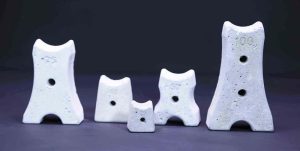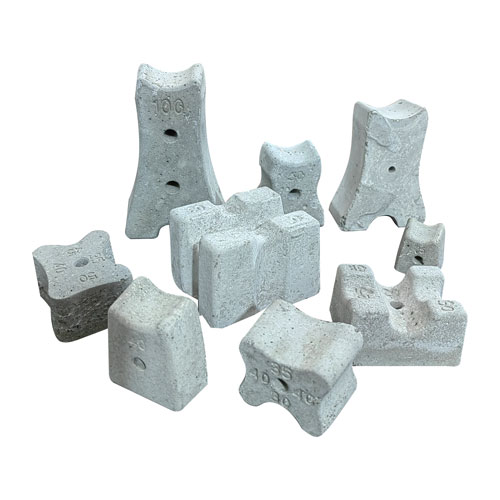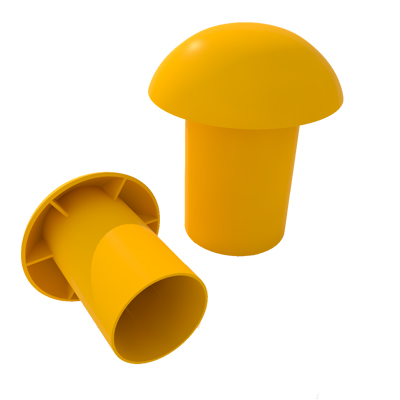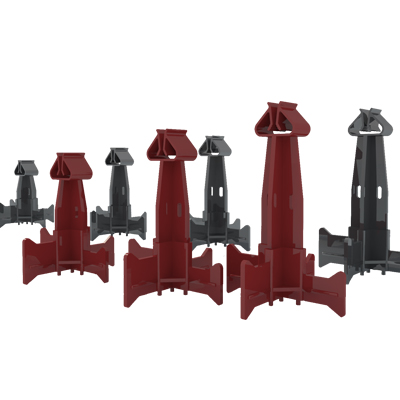Cement spacer
- It has be
- tter adhesion due to being concrete.
- Safer transfer of static loads to concrete
- Creates very high physical and chemical resistance
Description
Cement spacer
The concrete cover on rebars is essential and critical, as failing to maintain the proper spacing between rebars can significantly affect the durability of concrete structures, depending on environmental conditions and the type of structure. To achieve precise spacing, plastic and Cement spacer are used, each with its own advantages and limitations. Considering the benefits of concrete spacers over plastic ones and addressing market needs, Chemical Beton Plast Company has developed a variety of concrete rebar spacers in different sizes and models to meet the demands of contractors in this field.
Cement spacer provide a uniform cover over the reinforcement bars and offer benefits such as high durability, cost-effectiveness, ease of transportation, improved accuracy and speed of project execution, reduced manpower requirements, lower execution costs, seamless integration with concrete, and secure fixation of rebars.

Applications Cement spacer
- Suitable for areas like foundations and heavy floors where the use of plastic spacers is not feasible.
- Usable on all horizontal and vertical surfaces.
- Ideal for creating high-density concrete cover on rebar networks.
- Perfect for producing precast components and walls where a smooth surface without spacer marks is required.
- Applicable in acidic environments and for reinforcement in water and sewage networks.
- Suitable for structures such as bridge decks and tunnel walls.
More products: Spacer
features
- Due to being made of the same material as concrete, they provide better adhesion to the structure.
- They maintain their shape and do not deform when exposed to temperature fluctuations and changes.
- They transfer static loads to the concrete more safely.
- Fewer spacers are required per square meter compared to plastic ones under similar structural conditions.
- They have higher point load capacity compared to plastic spacers.
- They can be tied to the rebar network using wires.
- They provide better stability under the rebar during structural vibrations during rebar placement and concreting.
- They offer excellent physical and chemical resistance.
- After formwork removal, there are no visible traces of spacers on the concrete surface.
- They have higher resistance to heat, fire, and extreme temperatures compared to plastic spacers.
- They exhibit greater thermal compatibility during freeze-thaw cycles.
- In heavy floor structures, they are more cost-effective than plastic spacers.
- They perform better in various weather conditions and do not deform under heat.
- They significantly enhance the durability of concrete structures.
- They simplify the construction process.
How to Use Cement Spacer
For Vertical Surfaces:
After selecting the appropriate spacer, it is essential to attach the cement spacer to the rebar using the pre-designed holes and binding wire. Once the connection is secured, proceed with formwork and concreting.
For Horizontal Surfaces:
Based on the type of reinforcement and the required concrete cover thickness, the appropriate spacer is selected and placed under the rebars. If significant vibrations occur during reinforcement or concreting, it is recommended to secure the cement spacers to the rebars with binding wire to ensure they remain in position.
packing
| Name | Size (cm) | number in the box |
| Hard concrete rebar spacer 25 | 5/2 | 1000 |
| Hard concrete rebar spacer 30 | 3 | 700 |
| Hard concrete rebar spacer 40 | 4 | 350 |
| Hard concrete rebar spacer 50 | 5 | 220 |
| Hard concrete rebar spacer 75 | 5/7 | 100 |
| Hard concrete rebar spacer 100 | 10 | 70 |
| Small multifunctional cement spacer | 20/25/30 | 450 |
| Medium multifunctional cement spacer | 30/35/40 | 300 |
| Large multifunctional cement spacer | 35/40/45/50 | 220 |
| Small insole cement spacer | 20/25/40/50 | 200 |
| Large floor cement spacer | 30/40/50/60 | 90 |






Reviews
There are no reviews yet.